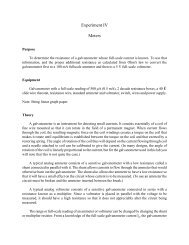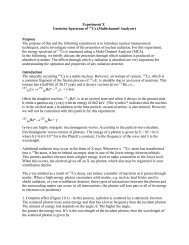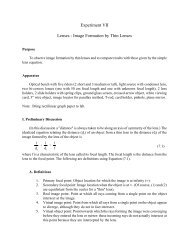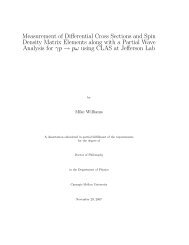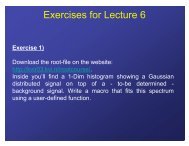Talk - Hadronic Nuclear Physics Group
Talk - Hadronic Nuclear Physics Group
Talk - Hadronic Nuclear Physics Group
You also want an ePaper? Increase the reach of your titles
YUMPU automatically turns print PDFs into web optimized ePapers that Google loves.
Cornell University Cleo lunch talk Volker Credé<br />
Open questions in hadron physics<br />
Spectroscopy with the Crystal–Barrel Detector<br />
Volker Credé<br />
• Introduction<br />
• The Crystal–Barrel Detector at LEAR (CERN)<br />
– Meson spectroscopy in pp reactions at rest and the search for exotic states<br />
• The Crystal–Barrel Experiment at ELSA: initial configuration (2000/2001)<br />
– Baryon spectroscopy (photoproduction of neutral mesons: E γ < 3 GeV )<br />
– γ p → p π 0 (p η) ⇒ differential and total cross sections<br />
– γ p → p π 0 π 0 (p π 0 η) ⇒ total cross sections and PWA<br />
• Summary and outlook: polarization measurements with CB/TAPS (2003)<br />
Wilson Laboratory for <strong>Nuclear</strong> Studies, Cornell University, Ithaca, NY 14853
Cornell University Cleo lunch talk Volker Credé<br />
Access to QCD and fundamental questions<br />
Breaking of chiral symmetry<br />
can be treated perturbatively<br />
very small energies<br />
resonance region at<br />
intermediate energies<br />
Application of perturbation<br />
theory allows access to QCD<br />
very large energies<br />
✲◮<br />
➜<br />
Do we understand bound systems within the framework of QCD ?<br />
⇒ Development of QCD-inspired models can help to find answers to ...<br />
... the fundamental questions<br />
• What are the relevant degrees of freedom and the corresponding effective<br />
interactions responsible for hadronic phenomena?<br />
• What are the mechanisms for confinement and for chiral symmetry breaking?
Cornell University Cleo lunch talk Volker Credé<br />
Renaissance of Hadron Spectroscopy<br />
Recently discovered new states ➜ Beginning of new spectroscopy ?<br />
Mesons<br />
• D ∗+<br />
sJ (2317) → D+ s<br />
π 0 at BaBar<br />
(B. Aubert et al., Phys. Rev. Lett. 90 (2003) 242001)<br />
• D + sJ<br />
(2457) → D∗+ s<br />
π 0 at CLEO<br />
(D. Besson et al., Phys. Rev. D68 (2003) 032002)<br />
⇒ Observation of missing<br />
0 + and 1 + states in the<br />
D + s (cs) system ?<br />
⇒ ... or even DK molecules<br />
or tetraquarks ?<br />
• B ± → K ± π + π − J/ψ at BELLE<br />
Baryons<br />
• Observation of Θ + with S = 1<br />
(LEPS, CLAS, DIANA, SAPHIR, etc.)<br />
• Observation of Ξ −− with Q = −2<br />
(C. Alt et al. [NA49 Coll.], hep–ex/0310014)<br />
⇒ Observation of pentaquark states<br />
as members of an antidecuplet ?<br />
Observation of an enhancement at<br />
pp threshold in J/ψ → γ η c → γ pp<br />
(BES Coll. at HADRON’03 conference)<br />
(S.K. Choi et al., hep–ex/0303032)
Cornell University Cleo lunch talk Volker Credé<br />
The quark model of hadrons<br />
• Mesons (qq) q ⊗ q = 3 ⊗ 3 = 8 ⊕ 1<br />
• Baryons (qqq) q ⊗ q ⊗ q = 3 ⊗ 3 ⊗ 3 = 10 ⊕ 8 ⊕ 8 ⊕ 1<br />
} {{ }<br />
Ordinary matter, however, QCD also predicts so–called exotic states<br />
⇒ simplest possibility: q ⊗ q ⊗ q = 15 ⊕ 6 ⊕ 3 ⊕ 3<br />
} {{ }<br />
➜<br />
Does not work: color singlets needed !<br />
⇒ multiple of (qqq) and (qq) necessary<br />
• Glueballs: g ⊗ g = 8 ⊗ 8 = 27 ⊕ 10 ⊕ 10 ⊕ 8 ⊕ 8 ⊕ 1<br />
• Hybrids: q ⊗ q ⊗ g = 27 ⊕ 10 ⊕ 10 ⊕ 8 ⊕ 8 ⊕ 8 ⊕ 1 ⇒ (qq) l ((q) 3 ) m (g) n ,<br />
l + m ≥ 1 for n = 1
Cornell University Cleo lunch talk Volker Credé<br />
The quark model of hadrons<br />
• Mesons (qq) q ⊗ q = 3 ⊗ 3 = 8 ⊕ 1<br />
• Baryons (qqq) q ⊗ q ⊗ q = 3 ⊗ 3 ⊗ 3 = 10 ⊕ 8 ⊕ 8 ⊕ 1<br />
} {{ }<br />
Ordinary matter, however, QCD also predicts so–called exotic states<br />
⇒ simplest possibility: q ⊗ q ⊗ q = 15 ⊕ 6 ⊕ 3 ⊕ 3<br />
} {{ }<br />
➜<br />
Does not work: color singlets needed !<br />
⇒ multiple of (qqq) and (qq) necessary<br />
• Glueballs: g ⊗ g = 8 ⊗ 8 = 27 ⊕ 10 ⊕ 10 ⊕ 8 ⊕ 8 ⊕ 1<br />
Exciting the flux tube<br />
➜<br />
Hybrids<br />
• Hybrids: q ⊗ q ⊗ g = 27 ⊕ 10 ⊕ 10 ⊕ 8 ⊕ 8 ⊕ 8 ⊕ 1 ⇒ (qq) l ((q) 3 ) m (g) n ,<br />
l + m ≥ 1 for n = 1
Cornell University Cleo lunch talk Volker Credé<br />
The quark model of hadrons<br />
• Mesons (qq) q ⊗ q = 3 ⊗ 3 = 8 ⊕ 1<br />
• Baryons (qqq) q ⊗ q ⊗ q = 3 ⊗ 3 ⊗ 3 = 10 ⊕ 8 ⊕ 8 ⊕ 1<br />
} {{ }<br />
Ordinary matter, however, QCD also predicts so–called exotic states<br />
⇒ simplest possibility: q ⊗ q ⊗ q = 15 ⊕ 6 ⊕ 3 ⊕ 3<br />
} {{ }<br />
➜<br />
Does not work: color singlets needed !<br />
⇒ multiple of (qqq) and (qq) necessary<br />
• Glueballs: g ⊗ g = 8 ⊗ 8 = 27 ⊕ 10 ⊕ 10 ⊕ 8 ⊕ 8 ⊕ 1<br />
Exciting the flux tube<br />
➜<br />
Hybrids<br />
• Hybrids: q ⊗ q ⊗ g = 27 ⊕ 10 ⊕ 10 ⊕ 8 ⊕ 8 ⊕ 8 ⊕ 1 ⇒ (qq) l ((q) 3 ) m (g) n ,<br />
• Multi–quark states l + m ≥ 1 for n = 1
Cornell University Cleo lunch talk Volker Credé<br />
The search for new forms of matter<br />
All exotic states of hadrons can be subdivided into three groups:<br />
1. States with explicitly exotic values of<br />
principal quantum numbers<br />
Θ + with S = 1<br />
Ξ −− with Q = −2
Cornell University Cleo lunch talk Volker Credé<br />
The search for new forms of matter<br />
All exotic states of hadrons can be subdivided into three groups:<br />
1. States with explicitly exotic values of<br />
principal quantum numbers<br />
Θ + with S = 1<br />
Ξ −− with Q = −2<br />
2. States with exotic combinations of J P C<br />
⇒<br />
forbidden for ordinary qq states:<br />
0 +− , 0 −− , 1 −+ , 2 +− , 3 −+ , etc.<br />
π 1 (1400) → ηπ −<br />
π 1 (1600) → η ′ π − ⎫<br />
⎬<br />
⎭ J P C = 1 −+
Cornell University Cleo lunch talk Volker Credé<br />
The search for new forms of matter<br />
All exotic states of hadrons can be subdivided into three groups:<br />
1. States with explicitly exotic values of<br />
principal quantum numbers<br />
Θ + with S = 1<br />
Ξ −− with Q = −2<br />
2. States with exotic combinations of J P C<br />
⇒<br />
forbidden for ordinary qq states:<br />
0 +− , 0 −− , 1 −+ , 2 +− , 3 −+ , etc.<br />
π 1 (1400) → ηπ −<br />
π 1 (1600) → η ′ π − ⎫<br />
⎬<br />
⎭ J P C = 1 −+<br />
3. States with hidden exotic properties<br />
⇒ Problem: predicted glueballs can<br />
mix with ordinary qq states<br />
f 0 (1500)<br />
}<br />
J P C = 0 ++<br />
Evidence far from solid<br />
⇒ Details needed for a full understanding are missing
Cornell University Cleo lunch talk Volker Credé<br />
Spectroscopy with the Crystal–Barrel Detector<br />
2000 - present (University of Bonn)<br />
• Photoproduction experiments at ELSA<br />
⇒ Spectroscopy of light baryons<br />
(... and mesons)<br />
1989 - 1996 (at LEAR/CERN)<br />
• Investigation of pp and pd annihilations<br />
⇒ Annihilation dynamics in the<br />
non-perturbative regime of QCD<br />
⇒ Search for baryonium (pp bound states)<br />
• Spectroscopy of light mesons
Cornell University Cleo lunch talk Volker Credé<br />
Photoproduction with the Crystal–Barrel Detector at ELSA<br />
Photoproduction<br />
2.0 < m pπ 0 π 0 < 2.1 (in GeV/c 2 )<br />
➜<br />
➜<br />
200<br />
150<br />
100<br />
50<br />
γ p → pπ 0 π 0<br />
0<br />
1000 1200 1400 1600 1800 2000<br />
Invariant pπ 0 mass [ MeV/c 2 ]<br />
➜<br />
Spectroscopy<br />
Baryon spectrosopy<br />
• Search for missing<br />
resonances
Cornell University Cleo lunch talk Volker Credé<br />
General Physical Motivation<br />
⇒ Search for missing resonances<br />
Quark models predict many more baryons than have been observed<br />
**** *** ** *<br />
N spectrum 11 3 6 2<br />
∆ spectrum 7 3 6 6<br />
⇒<br />
⇒<br />
according to PDG<br />
(Phys. Rev. D66 (2002) 010001)<br />
little known<br />
(many open questions left)<br />
Possible solutions:<br />
a) Quark-diquark structure<br />
one of the<br />
internal degrees<br />
of freedom<br />
is frozen<br />
b) They have not been observed, yet<br />
Nearly all existing data result from<br />
πN scattering experiments<br />
⇒ If the missing resonances did not couple to<br />
Nπ, they would not have been discovered!!<br />
(supported by theory)
Cornell University Cleo lunch talk Volker Credé<br />
Quark models and experimental overview<br />
Effective theories and models necessary to make spectroscopic predictions<br />
Basic assumption: linear confinement potential + residual short–range interaction<br />
• Goldstone–boson (pion) exchange<br />
(L.Y. Glozman, W. Plessas, K. Varga and R.F. Wagenbrunn, Phys. Rev. D58 (1998) 094030)<br />
• One–gluon exchange (S. Capstick and N. Isgur, Phys. Rev. D34 (1986) 2809)<br />
(relativized quark model) 1. wrong spin–orbit couplings<br />
2. no explanation for parity doublets<br />
• Instanton–induced interaction<br />
(relativistic quark model)<br />
1. acceptable Regge trajectories<br />
2. natural explanation for parity doublets<br />
Which is the right model?<br />
⇒ Do we have a correct model? Is there really one interaction that dominates?
Cornell University Cleo lunch talk Volker Credé<br />
Symmetries and classification<br />
| qqq 〉 = | colour 〉 A · | space; spin, flavour 〉 S<br />
O(6) SU(6) → SU(2)| spin ⊗ SU(3)| flavour<br />
⇒ Total wave function antisymmetric with respect to exchange of two quarks<br />
SU(6) symmetry: (Notation: 2S+1 multiplet)<br />
6 ⊗ 6 ⊗ 6 = 56 S ⊕ 70 M ⊕ 70 M ⊕ 20 A<br />
⇒ 56 = 4 10 ⊕ 2 8<br />
70 = 2 10 ⊕ 4 8 ⊕ 2 8 ⊕ 2 1<br />
20 = 2 8 ⊕ 4 1<br />
Notation for baryon resonances:<br />
(example)<br />
S 11 (1535) ⇐⇒ N 1<br />
2<br />
−(1535)<br />
Classification of multiplets (D, L P N ):<br />
ground state (56, 0 + 0 ):<br />
∆ 3<br />
2<br />
+(1232) ɛ 4 10<br />
N 1<br />
2<br />
+(939) ɛ 2 8<br />
1. excited state (70, 1 − 1 ):<br />
∆ 1 −(1620),<br />
2<br />
∆ 3 −(1700)<br />
2<br />
ɛ 2 10<br />
N 1 −(1535),<br />
2<br />
N 3 −(1520)<br />
2<br />
ɛ 2 8<br />
N 1 −(1650), N 3 −(1700)<br />
2<br />
2<br />
N 5 −(1675)<br />
2<br />
ɛ 4 8
¢¡<br />
¥¤ £<br />
§¦<br />
¥¨¤<br />
¦ ¢©¦ ¨¤<br />
Cornell University Cleo lunch talk Volker Credé<br />
3000<br />
2500<br />
—— U. Löhring, B.C. Metsch and H.R. Petry, Eur. Phys. J. A10, 395-446 (2001)<br />
missing<br />
resonances<br />
2700<br />
**<br />
2600<br />
***<br />
Mass [MeV]<br />
2000<br />
1500<br />
2100<br />
*<br />
1986<br />
2000 1990<br />
S<br />
1900<br />
** **<br />
**<br />
1710 1720<br />
1680<br />
***<br />
****<br />
****<br />
1440<br />
****<br />
2220<br />
****<br />
2090<br />
2080<br />
* **<br />
1897 1895<br />
S S<br />
1700<br />
1650 ***<br />
****<br />
1535 1520<br />
**** ****<br />
2200<br />
**<br />
1675<br />
****<br />
2190<br />
****<br />
2250<br />
****<br />
1000<br />
L<br />
J π<br />
2T 2J<br />
939<br />
****<br />
Bonn model: residual short–range interaction<br />
based on instanton–induced forces<br />
1/2+ 3/2+ 5/2+ 7/2+ 9/2+ 11/2+ 13/2+ 1/2- 3/2- 5/2- 7/2- 9/2- 11/2- 13/2-<br />
P11 P F15 F17<br />
H19<br />
H K S11 D13 D15 G17 G19<br />
I I<br />
13 1 11 1 13 1 11 1 13
Cornell University Cleo lunch talk Volker Credé<br />
Nucleon resonances<br />
—— S. Capstick and N. Isgur, Phys. Rev. D34 (1986) 2809<br />
3000<br />
**<br />
2500<br />
***<br />
****<br />
** ****<br />
****<br />
Mass [MeV]<br />
2000<br />
*<br />
S<br />
***<br />
**<br />
****<br />
** **<br />
****<br />
* **<br />
S S<br />
***<br />
****<br />
****<br />
1500<br />
****<br />
****<br />
****<br />
1000<br />
****<br />
OGE model: residual short–range interaction<br />
based on one–gluon exchange<br />
J π 1/2+ 3/2+ 5/2+ 7/2+ 9/2+ 11/2+ 13/2+ 1/2- 3/2- 5/2- 7/2- 9/2- 11/2- 13/2-
Cornell University Cleo lunch talk Volker Credé<br />
—— U. Löhring, B.C. Metsch and H.R. Petry, Eur. Phys. J. A10, 395-446 (2001)<br />
3000<br />
2950<br />
**<br />
2750<br />
**<br />
2500<br />
2390<br />
*<br />
2300<br />
**<br />
2420<br />
****<br />
2150<br />
*<br />
2350<br />
*<br />
2200<br />
*<br />
2400<br />
**<br />
Mass [MeV]<br />
2000<br />
1500<br />
1910<br />
****<br />
1750<br />
*<br />
1920<br />
***<br />
1600<br />
***<br />
2000<br />
**<br />
1905<br />
****<br />
➜<br />
1950<br />
****<br />
too low in mass<br />
➜<br />
1900<br />
**<br />
1620<br />
****<br />
1940 1930<br />
* ***<br />
1700<br />
****<br />
****<br />
Bonn model: residual short–range interaction<br />
based on instanton–induced forces<br />
1232<br />
1000<br />
J π 1/2+ 3/2+ 5/2+ 7/2+ 9/2+ 11/2+ 13/2+ 15/2+ 1/2- 3/2- 5/2- 7/2- 9/2- 11/2- 13/2- 15/2-<br />
L 2T 2J P P 33 H K K S D<br />
G I<br />
35 37 39 H 3 11 3 13 3 15 33 35 37 39 I 3 11 3 13<br />
31 F F 31 D G
Cornell University Cleo lunch talk Volker Credé<br />
∆ resonances<br />
—— S. Capstick and N. Isgur, Phys. Rev. D34 (1986) 2809<br />
3000<br />
**<br />
**<br />
2500<br />
*<br />
**<br />
****<br />
*<br />
**<br />
*<br />
*<br />
Mass [MeV]<br />
2000<br />
1500<br />
****<br />
*<br />
*** ****<br />
***<br />
**<br />
➜<br />
****<br />
too low in mass<br />
➜<br />
**<br />
****<br />
* ***<br />
****<br />
1000<br />
****<br />
OGE model: residual short–range interaction<br />
based on one–gluon exchange<br />
J π 1/2+ 3/2+ 5/2+ 7/2+ 9/2+ 11/2+ 13/2+ 15/2+ 1/2- 3/2- 5/2- 7/2- 9/2- 11/2- 13/2- 15/2-
Cornell University Cleo lunch talk Volker Credé<br />
The Electron Stretcher Ring ELSA<br />
Investigation of the nucleon structure with a 4π high-resolution photon detector<br />
at the Electron Stretcher Accelerator ELSA in Bonn<br />
Collaboration of<br />
• Basel<br />
• Bochum<br />
Stretcher Ring<br />
• Bonn<br />
• Dresden<br />
• Erlangen<br />
• Gatchina<br />
• Gießen<br />
• Groningen<br />
• Münster
Cornell University Cleo lunch talk Volker Credé<br />
The Crystal–Barrel Experiment at ELSA<br />
Photoproduction experiment using a liquid H 2 target<br />
(unpolarized in a first series of experiments → 2000/2001)<br />
Inner Detector<br />
Crystal Barrel<br />
Tagging Magnet<br />
Tagging range:<br />
25 % − 93 % of incoming E e −<br />
Target<br />
Tagger<br />
Radiator<br />
E e − = 1.4 GeV<br />
0.35 GeV ≤ E γ ≤ 1.3 GeV<br />
1.2 GeV/c 2 ≤ √ s ≤ 1.8 GeV/c 2<br />
γ e -<br />
e - -<br />
E e − = 3.2 GeV<br />
0.8 GeV ≤ E γ ≤ 3.0 GeV<br />
1.5 GeV/c 2 ≤ √ s ≤ 2.6 GeV/c 2<br />
E = E - E<br />
γ 0 e
Cornell University Cleo lunch talk Volker Credé<br />
The tagging system<br />
• 14 scintillation counters<br />
• 2 wire chambers (352 wires)<br />
• tagging range: 25 % − 92 %<br />
electrons<br />
radiator<br />
magnet<br />
photons<br />
primary electron beam<br />
beam dump<br />
high photon energies<br />
low photon energies
Cornell University Cleo lunch talk Volker Credé<br />
Target and inner detector<br />
The inner detector:<br />
• 3 layers of scintillating fibres<br />
(⇒ additional reconstruction point)<br />
• Trigger on charged tracks<br />
1 cm
Cornell University Cleo lunch talk Volker Credé<br />
The Crystal–Barrel Experiment at ELSA<br />
➜<br />
Tagging magnet<br />
➜<br />
Barrel calorimeter
Cornell University Cleo lunch talk Volker Credé<br />
Cross section of a CsI(Tl) module<br />
LEAR:<br />
operation in a magnetic field of 1.5 T<br />
⇓<br />
silicon photodiodes to read out<br />
scintillation light<br />
0.1 mm titanium can<br />
1<br />
circuit board<br />
6<br />
5<br />
light fibre<br />
2 mm Titan<br />
CsI(Tl)<br />
4<br />
preamplifier<br />
10 cm<br />
3<br />
photodiode<br />
2<br />
wavelength shifter
Cornell University Cleo lunch talk Volker Credé<br />
Segmentation in Φ<br />
Segmentation in Θ<br />
20 × 60 crystals (type 1-10), opening angle 6 ◦<br />
6 × 30 crystals (type 11-13), opening angle 12 ◦<br />
26 rings of crystals, opening angle 6 ◦<br />
The barrel calorimeter
$ %&<br />
! #<br />
"<br />
'<br />
!" )<br />
(!) "<br />
('&<br />
" %$# !<br />
Cornell University Cleo lunch talk Volker Credé<br />
Arrangement and parameters of crystal modules<br />
6 o 12 o Φ<br />
8<br />
9<br />
10<br />
11<br />
12<br />
13<br />
7<br />
6<br />
5<br />
4<br />
3<br />
2<br />
1<br />
1 2 3 4 5 6 7 8<br />
9<br />
10<br />
11<br />
12<br />
13<br />
Θ<br />
Density 4.53 g/cm 3<br />
Radiation length L 0<br />
1.86 cm<br />
Moliére radius<br />
3.8 cm<br />
13<br />
12<br />
11<br />
10<br />
9<br />
8<br />
7<br />
6<br />
5<br />
4<br />
3<br />
2<br />
1<br />
13<br />
12<br />
11<br />
10<br />
9<br />
1 2 3 4 5 6 7 8<br />
Light output<br />
0.85 relative to NaI<br />
Maximum emission<br />
550 nm<br />
Decay times 0.9 and 7 µs<br />
Photon yield<br />
4.5 × 10 4 /MeV<br />
Crystal length 30 cm = 16.1 L 0<br />
Solid angle<br />
97.8 % of 4π<br />
Typ. signal<br />
2000 photons / MeV<br />
Total weight<br />
5 t
Cornell University Cleo lunch talk Volker Credé<br />
The FACE trigger<br />
projection onto x axis<br />
projection onto y axis<br />
• cellular logic<br />
• decision time ≈ 4 µsec<br />
1<br />
1<br />
1<br />
1<br />
marking a cluster<br />
counting and removing
Cornell University Cleo lunch talk Volker Credé<br />
Photoproduction of π 0 / η mesons<br />
Excitation spectra and quantum<br />
numbers alone do not provide very<br />
sensitive tests of hadron models<br />
➜<br />
Models also have to ...<br />
• predict transitions between states<br />
Unknown<br />
branching<br />
fractions for η decays<br />
• link observables to fundamental<br />
questions<br />
⇒ Little known on η decays !
Cornell University Cleo lunch talk Volker Credé<br />
• Selection according to the number<br />
of clusters in the Crystal Barrel<br />
• Identification of protons via inner<br />
scintillating fibre detector<br />
• Kinematic fitting<br />
(e.g. 3π 0 and missing proton)<br />
10 6 6000<br />
5000 ~ 78000 (a)<br />
4000 η → 2 γ<br />
3000<br />
2000<br />
10 5<br />
1000<br />
400 500 600<br />
10 4<br />
Reconstruction<br />
2500<br />
2000<br />
1500<br />
1000<br />
500<br />
~ 21000 (b)<br />
0<br />
η → 3 π<br />
400 500 600<br />
10 3<br />
10 5 2<br />
10 4<br />
10 3<br />
10 2<br />
10<br />
1<br />
π 0<br />
η<br />
200 400 600 800<br />
MeV/c<br />
10 2<br />
100 200 300 400 500 600<br />
m γ γ [MeV/c<br />
ω<br />
η<br />
′ from hep-ph/0311045<br />
on eta photoproduction<br />
➜<br />
Invariant γγ mass<br />
➜<br />
2<br />
]
Cornell University Cleo lunch talk Volker Credé<br />
Differential cross sections for the reaction γ p → p π 0<br />
d σ/d Ω [µb/sr]<br />
—– SAID predictions —— CB–ELSA fit<br />
300 - 325 325 - 350 350 - 375 375 - 400 400 - 425 425 - 450<br />
20<br />
0<br />
10<br />
5<br />
0<br />
6<br />
4<br />
450 - 475 475 - 500 500 - 525 525 - 550 550 - 575 575 - 600<br />
Preliminary<br />
600 - 625 625 - 650 650 - 675 675 - 700 700 - 725 725 - 750<br />
0<br />
-3<br />
0<br />
-1<br />
2<br />
0<br />
-1 -0.5 0 0.5 1<br />
-0.5 0 0.5 1<br />
-0.5 0 0.5 1<br />
-0.5 0 0.5 1<br />
-0.5 0 0.5 1<br />
-0.5 0 0.5 1<br />
cos θ cm<br />
0<br />
-0.4<br />
PhD thesis Harald van Pee, Bonn 2003
Cornell University Cleo lunch talk Volker Credé<br />
Differential cross sections for the reaction γ p → p π 0<br />
d σ/d Ω<br />
6<br />
4<br />
[µb/sr]<br />
—– SAID predictions —— CB–ELSA fit<br />
750 - 775 775 - 800 800 - 825 825 - 850 850 - 875 875 - 900<br />
2<br />
0<br />
4<br />
2<br />
0<br />
3<br />
2<br />
900 - 925 925 - 950 950 - 975 975 - 1000 1000 - 1025 1025 - 1050<br />
Preliminary<br />
1050 - 1075 1075 - 1100 1100 - 1125 1125 - 1150 1150 - 1175 1175 - 1200<br />
0<br />
-0.4<br />
0<br />
-0.3<br />
1<br />
0<br />
-1 -0.5 0 0.5 1<br />
-0.5 0 0.5 1<br />
-0.5 0 0.5 1<br />
-0.5 0 0.5 1<br />
-0.5 0 0.5 1<br />
-0.5 0 0.5 1<br />
cos θ cm<br />
0<br />
-0.3<br />
PhD thesis Harald van Pee, Bonn 2003
Cornell University Cleo lunch talk Volker Credé<br />
Differential cross sections for the reaction γ p → p π 0<br />
d σ/d Ω<br />
3<br />
2<br />
[µb/sr]<br />
—– SAID predictions —— CB–ELSA fit<br />
1200 - 1225 1225 - 1250 1250 - 1275 1275 - 1300 1300 - 1350 1350 - 1400<br />
1<br />
0<br />
3<br />
2<br />
1<br />
0<br />
1<br />
1400 - 1450 1450 - 1500 1500 - 1550 1550 - 1600 1600 - 1650 1650 - 1700<br />
Preliminary<br />
1700 - 1750 1750 - 1800 1800 - 1850 1850 - 1900 1900 - 1950 1950 - 2000<br />
0<br />
-0.2<br />
0<br />
-0.2<br />
0<br />
-1 -0.5 0 0.5 1<br />
-0.5 0 0.5 1<br />
-0.5 0 0.5 1<br />
-0.5 0 0.5 1<br />
-0.5 0 0.5 1<br />
-0.5 0 0.5 1<br />
cos θ cm<br />
0<br />
-0.1<br />
PhD thesis Olivia Bartholomy, Bonn 2004
Cornell University Cleo lunch talk Volker Credé<br />
Differential cross sections for the reaction γ p → p π 0<br />
d σ/d Ω [µb/sr]<br />
—– SAID predictions —— CB–ELSA fit<br />
2000 - 2050 2050 - 2100 2100 - 2150 2150 - 2200 2200 - 2250 2250 - 2300<br />
1<br />
0<br />
2300 - 2400 2400 - 2500 2500 - 2600 2600 - 2800 2800 - 3000 -0.5 0 0.5 1<br />
1<br />
0<br />
0<br />
-0.1<br />
-1 -0.5 0 0.5 1 -0.5 0 0.5 1 -0.5 0 0.5 1 -0.5 0 0.5 1 -0.5 0 0.5 1<br />
cos θ cm<br />
Preliminary<br />
0<br />
-0.1<br />
PhD thesis Olivia Bartholomy, Bonn 2004
Cornell University Cleo lunch talk Volker Credé<br />
Total cross section for the reaction γ p → p π 0<br />
d σ/d Ω<br />
1<br />
[µb/sr]<br />
σ tot<br />
[µb]<br />
E γ<br />
[GeV]<br />
2000 - 2050 2050 - 2100 2100 - 2150 2150 - 2200 2200 - 2250 2250 - 2300<br />
400<br />
300<br />
200<br />
0.5 1 1.5 2 2.5<br />
0<br />
1<br />
0<br />
100<br />
2300 - 2400 2400 - 2500 2500 - 2600 2600 - 2800 2800 - 3000<br />
10<br />
-1 -0.5 0 0.5 1 -0.5 0 0.5 1 -0.5 0 0.5 1 -0.5 0 0.5 1 -0.5 0 0.5 1<br />
Preliminary<br />
-0.5 0 0.5 1<br />
0<br />
-0.1<br />
cos<br />
θ cm<br />
0<br />
-0.1<br />
1.4 1.6 1.8 2 2.2 2.4<br />
W [GeV]<br />
PhD thesis Olivia Bartholomy, Bonn 2004
Cornell University Cleo lunch talk Volker Credé<br />
Investigation of the reaction γ p → p π 0<br />
Aspects of pion production for CB-ELSA<br />
• Understanding of detector acceptances in preparation for partial wave analyses<br />
also for other channels (γ p → p π 0 π 0 , γ p → p π 0 η, etc.)<br />
• Normalisation (photon flux) by fitting angular distributions to known SAID<br />
predictions ➜ cross check with hardware measurements<br />
• Better understanding of high-energy behaviour<br />
⇒ E γ > 2 GeV:<br />
t–channel vector–meson exchanges are better described in terms of Regge<br />
trajectories ➜ allows extrapolation towards lower energies<br />
Resonances are excited up to the highest available photon energies,<br />
however, strong production of pions in the forward direction is observed<br />
above 2.4 GeV (presumably exchange of mesons in the t–channel)
Cornell University Cleo lunch talk Volker Credé<br />
Investigation of the reaction γ p → p η<br />
7000<br />
6000<br />
5000<br />
η → 3π 0<br />
➜<br />
⎧<br />
⎨<br />
⎩<br />
η → 3π 0<br />
(CB − ELSA)<br />
4000<br />
3000<br />
2000<br />
1000<br />
N<br />
η = 16105<br />
σ = 9.71013<br />
0<br />
300 400 500 600 700<br />
Invariant π 0 π 0 π 0 mass [ MeV/c 2 ]<br />
γ p → p X (missing mass)<br />
(CLAS)<br />
⎫<br />
⎬<br />
⎭<br />
➜
Cornell University Cleo lunch talk Volker Credé<br />
Investigation of the reaction γ p → p η<br />
120<br />
100<br />
80<br />
60<br />
R = 0.825 ± 0.001 ± 0.005<br />
BR(η → 3π 0 ) ≈ 32.5 %<br />
BR(η → γγ) ≈ 39.4 %<br />
R = BR (η → 3π0 )<br />
BR (η → 2γ)<br />
for each bin in dσ/dΩ<br />
weighted by 1/σ 2<br />
40<br />
PDG:<br />
20<br />
0<br />
0 0.2 0.4 0.6 0.8 1 1.2 1.4 1.6 1.8 2<br />
• 0.826 ± 0.024<br />
• 0.832 ± 0.013<br />
• 0.841 ± 0.037<br />
SND<br />
TAPS<br />
CBAR<br />
⇒ Data for η → γγ and η → 3π 0 can be added up !
Cornell University Cleo lunch talk Volker Credé<br />
2<br />
Differential cross sections for the reaction γ p → p η<br />
CB-ELSA —— CB–ELSA fit △ GRAAL ◦ CLAS ⋆ TAPS<br />
dσ/dΩ [ µb/sr ]<br />
Crede et al., hep-ph/0311045, submitted to Phys. Rev. Lett.<br />
750 - 800 800 - 850 850 - 900 900 - 950 950 - 1000 1000 - 1050<br />
1<br />
0<br />
0.5<br />
1050 - 1100 1100 - 1150 1150 - 1200 1200 - 1250 1250 - 1300 1300 - 1350<br />
0<br />
-0.5<br />
0<br />
0.5<br />
1350 - 1400 1400 - 1450 1450 - 1500 1500 - 1550 1550 - 1600 1600 - 1650<br />
0<br />
-0.05<br />
0<br />
0<br />
-1 -0.5 0 0.5 1<br />
-0.5 0 0.5 1<br />
-0.5 0 0.5 1<br />
-0.5 0 0.5 1<br />
-0.5 0 0.5 1<br />
-0.5 0 0.5 1<br />
-0.05<br />
cos θ cm
Cornell University Cleo lunch talk Volker Credé<br />
Differential cross sections for the reaction γ p → p η<br />
CB-ELSA —— CB–ELSA fit ◦ CLAS<br />
dσ/dΩ [ µb/sr ]<br />
Crede et al., hep-ph/0311045, submitted to Phys. Rev. Lett.<br />
0.5<br />
1650 - 1700 1700 - 1750 1750 - 1800 1800 - 1850 1850 - 1900 1900 - 1950<br />
0<br />
0.5<br />
1950 - 2000 2000 - 2050 2050 - 2100 2100 - 2150 2150 - 2200 2200 - 2250<br />
0<br />
-0.05<br />
0<br />
0.5<br />
2250 - 2300 2300 - 2400 2400 - 2500 2500 - 2600 2600 - 2800 2800 - 3000<br />
0<br />
-0.05<br />
0<br />
0<br />
-1 -0.5 0 0.5 1<br />
-0.5 0 0.5 1<br />
-0.5 0 0.5 1<br />
-0.5 0 0.5 1<br />
-0.5 0 0.5 1<br />
-0.5 0 0.5 1<br />
-0.05<br />
cos θ cm
Cornell University Cleo lunch talk Volker Credé<br />
Models describing differential cross sections for γ p → p η<br />
• Multipole analysis (L. Tiator et al.: PRC 60 (1999) 035210)<br />
Bonn as well as Mainz cross section data,<br />
Graal beam polarization up to 1100 MeV<br />
⇒ S 11 (1535), D 13 (1520), S 11 (1650), D 15 (1675), P 11 (1440), F 15 (1680)<br />
• Isobar model (ETA-MAID by W.T. Chiang, L. Tiator)<br />
⇒ S 11 (1535), D 13 (1520), S 11 (1650), D 15 (1675), F 15 (1680), D 13 (1700),<br />
P 11 (1710), P 13 (1720) + (ρ, ω) exchange in the t–channel<br />
• Coupled–channel analysis (C. Bennhold et al.: PRC 58 (1998), 457 PRC 59 (1999), 460)<br />
⇒ all known spin–1/2 and spin–3/2 resonances included up to 2 GeV<br />
+ (ρ, ω) exchange in the t–channel<br />
⇒ only S 11 (1535), D 13 (1520), S 11 (1650), D 13 (1700) of importance<br />
• Chiral constituent quark model (B. Saghai and Z. Li: proceedings of N ∗ conference 2002)<br />
⇒ all known *** and **** resonances included, no t–exchange contributions !<br />
⇒ third S 11 (m = 1780 MeV, Λ = 280 MeV): CLAS data up to E γ = 2 GeV
Cornell University Cleo lunch talk Volker Credé<br />
Total cross section for the reaction γ p → p η<br />
σ tot<br />
20<br />
15<br />
10<br />
5<br />
[µb]<br />
E γ<br />
1 1.5 2 2.5<br />
[GeV]<br />
CB–ELSA data <br />
CB–ELSA fit ——<br />
GRAAL △<br />
CLAS ◦<br />
TAPS ⋆<br />
➜<br />
⎧<br />
⎪⎨<br />
⎪⎩<br />
The angular coverage of new<br />
CB–ELSA data allows determination<br />
of the total cross section<br />
CB-ELSA: Hint for N ∗ resonance (2080)D 15<br />
(hep-ph/0311045)<br />
⇒ Needs confirmation !<br />
1.6 1.8 2 2.2 2.4<br />
W [GeV]<br />
⇒ No need for third S 11<br />
Remaining questions:<br />
• How do baryon resonances couple to η mesons ?<br />
• Is there evidence for a third S 11 at 1780 MeV ?<br />
• How are η mesons produced at high energies ?
Cornell University Cleo lunch talk Volker Credé<br />
Hidden symmetry for η decays ?<br />
L=3<br />
S=3/2<br />
S=1/2<br />
ND13<br />
N(2200) D15 N(2190)G17 N(2250)G19<br />
N(2080)D15 N(2080)G17<br />
L=2<br />
S=3/2<br />
S=1/2<br />
N(2100)P11<br />
N(1900)P13 N(2000)F15 N(1990)F17<br />
N(1720)P13<br />
N(1680)F15<br />
L=1<br />
S=3/2<br />
S=1/2<br />
N(1650)S11 N(1700)D13 N(1675)D15<br />
N(1535)S11<br />
N(1520)D13<br />
J=1/2<br />
J=3/2 J=5/2 J=7/2 J=9/2
Cornell University Cleo lunch talk Volker Credé<br />
Investigation of the reaction γ p → p π 0 η<br />
Data comprises full statistics of a 2001 production run with E e<br />
−<br />
= 3.2 GeV:<br />
Events<br />
—– CL CL >10%<br />
pπ pπ0 10 4 0 γγ<br />
> 10% γγ<br />
10 3<br />
10 2<br />
10<br />
1<br />
⇒<br />
—– CL CL >10% and CL 10% and γγ CL pπ 0 η<br />
< pπ 0 η —– CL CL >10% and CL pπ0 10% and γγ CL pπ 0 π 0 pπ< 0 π 0<br />
100 200 300 400 500 600 700 800 900 1000<br />
γ p → p π 0 γγ ⇒ M γγ [MeV/c 2 ]<br />
Signal to background ratio for mesons:<br />
Selection<br />
• for η meson in the reaction γ p → p π 0 η: ≈ 16 : 1<br />
• for π 0 meson in the reaction γ p → p π 0 π 0 : ≈ 30 : 1<br />
• 5-particle final states<br />
• proton identification:<br />
inner detector<br />
• kinematic fitting<br />
– energy as well as<br />
momentum conservation<br />
– mass constraints
Cornell University Cleo lunch talk Volker Credé<br />
Mass plots for the reaction γ p → p π 0 η (E e − = 3.2 GeV)<br />
450<br />
400<br />
350<br />
300<br />
250<br />
200<br />
150<br />
100<br />
50<br />
a b<br />
0<br />
1000 1500 2000 2500 3000<br />
Invariant pπ 0 η mass [ MeV/c 2 ]<br />
Do we observe ∆ ∗ → ∆(1232)η ?<br />
γ<br />
⇒<br />
✕<br />
∆ ∗<br />
✙<br />
p<br />
❘<br />
π 0<br />
η<br />
c<br />
∆(1232)<br />
1.8 < √ s < 2.0 (in GeV/c 2 )<br />
forming invariant<br />
pπ 0 mass for (b)<br />
➜<br />
2.2 < √ s < 2.35 (in GeV/c 2 )<br />
forming invariant<br />
pπ 0 mass for (c)<br />
➜<br />
600<br />
500<br />
400<br />
300<br />
200<br />
100<br />
120<br />
100<br />
0<br />
1000 1200 1400 1600<br />
Invariant pπ 0 mass [ MeV/c 2 ]<br />
80<br />
60<br />
40<br />
20<br />
∆(1232)<br />
∆(1232)<br />
0<br />
1000 1200 1400 1600 1800 2000<br />
Invariant pπ 0 mass [ MeV/c 2 ]<br />
?
Cornell University Cleo lunch talk Volker Credé<br />
Mass plots for the reaction γ p → p π 0 η (E e − = 3.2 GeV)<br />
500<br />
400<br />
300<br />
200<br />
γγp p →pπ ηp π 0 η<br />
forming invariant<br />
π 0 η mass<br />
➜<br />
1.8 < √ s < 2.0 (in GeV/c 2 )<br />
0<br />
600 650 700 750 800 850 900 950 1000 1050<br />
350<br />
300<br />
250<br />
200<br />
150<br />
100<br />
50<br />
0<br />
Invariant pπ η mass 1800-2000 [MeV/c ]<br />
2<br />
100<br />
0<br />
600 700 800 900 1000 11001200 1300 1400 1500<br />
0<br />
2<br />
Invariant π η mass [MeV/c ]<br />
Parameters for a 0 (980) production:<br />
• E threshold ≈ 1490 MeV<br />
⇒ √ s ≈ 1920 MeV/c 2<br />
Do we observe γ p → ∆ ∗ → a 0 (980)p?<br />
forming invariant<br />
π 0 η mass<br />
➜<br />
0<br />
300<br />
250<br />
200<br />
150<br />
100<br />
50<br />
0<br />
2<br />
Invariant π η mass [MeV/c ]<br />
2.0 < √ s < 2.2 (in GeV/c 2 )<br />
0<br />
Invariant pπ η mass 2000-2200 [MeV/c ]<br />
a 0 (980)<br />
0<br />
600 700 800 900 1000 1100 1200 1300<br />
0<br />
2<br />
Invariant π η mass [MeV/c ]<br />
2
Cornell University Cleo lunch talk Volker Credé<br />
Total cross section of γ p → p π 0 η<br />
Performing a PWA: first results<br />
µb]<br />
σ [<br />
Total cross sections with 20 20 MeV bin size<br />
14<br />
12<br />
10<br />
8<br />
6<br />
4<br />
0<br />
γp → pπ η<br />
γp → pπ 0 π 0<br />
GRAAL<br />
Preliminary<br />
• New resonances necessary in order<br />
to describe data:<br />
⇒ evidence for (I = 3 −<br />
2 , J =<br />
3 −<br />
2 )<br />
at ≈ 2.2 GeV<br />
• Hints for contributions from the<br />
reaction ∆ ∗ → a 0 (980)p<br />
2<br />
1600 1800 2000 2200 2400<br />
s [ MeV ]<br />
Unbinned maximum likelihood fit:<br />
• event-based fit (important for #particles ≥ 3)<br />
• takes all correlations properly into account<br />
(5 independent variables)<br />
• Question of negative–parity ∆ states<br />
around 1900 MeV:<br />
⇒ solutions ambiguous<br />
(polarization necessary)<br />
⇒ CB/TAPS
Cornell University Cleo lunch talk Volker Credé<br />
1200<br />
1000<br />
800<br />
600<br />
400<br />
200<br />
Investigation of the reaction γ p → p π 0 π 0 (E e − = 3.2 GeV)<br />
1.6 < √ s < 1.75 (in GeV) 1.87 < √ s < 1.98 (in GeV) 2.0 < √ s < 2.1 (in GeV)<br />
∆(1232)<br />
500<br />
400<br />
300<br />
200<br />
100<br />
∆(1232)<br />
D 13 (1520)<br />
x<br />
0<br />
1000 1200 1400 1600 1800 2000<br />
0<br />
1000 1200 1400 1600 1800 2000<br />
0<br />
1000 1200 1400 1600 1800 2000<br />
Invariant pπ 0 mass [ MeV/c 2 ]<br />
Invariant pπ 0 mass [ MeV/c 2 ]<br />
Invariant pπ 0 mass [ MeV/c 2 ]<br />
x 10 3<br />
x 10 3<br />
10 3<br />
40 4000<br />
20<br />
2800<br />
140 3250<br />
35<br />
18<br />
3500<br />
120<br />
16<br />
30<br />
2400<br />
2750<br />
100<br />
3000<br />
14<br />
25<br />
12<br />
2000<br />
80 2250<br />
20 2500<br />
10<br />
60<br />
15<br />
8<br />
1600<br />
1750<br />
2000<br />
6<br />
40<br />
10<br />
1200<br />
20<br />
1500<br />
4<br />
1250<br />
5<br />
2<br />
0<br />
0 1000<br />
0<br />
1000 1500 2000 2500 3000<br />
1000 1500 2000 2500 3000 3500<br />
1500 2500 3500<br />
m 2 x 10 3 x 10 3 x 10 3 pπ 0 [MeV/c 2 ] 2 m 2 pπ 0 [MeV/c 2 ] 2 m 2 pπ 0 [MeV/c 2 ] 2<br />
250<br />
200<br />
150<br />
100<br />
50
Cornell University Cleo lunch talk Volker Credé<br />
New challenges: linear polarization and CB–TAPS<br />
Goniometer<br />
v<br />
amorphous radiators<br />
screen<br />
z<br />
h<br />
empty position<br />
wires for determination<br />
of beam profiles<br />
diamond crystal<br />
Crystal Barrel<br />
• 180 CsI crystals removed<br />
in the forward direction<br />
Data taking: Sep. 2002 – Dec. 2003<br />
• (un)polarized photon beam<br />
• liquid H 2 , deuterium<br />
• solid targets<br />
TAPS<br />
• 512 BaF crystals<br />
• forward detector<br />
– high granularity<br />
– fast trigger
Cornell University Cleo lunch talk Volker Credé<br />
CB–TAPS: ⃗γ p → p π 0 η<br />
Polarization observables provide additional pieces of information<br />
⇒ Results of PWA for the reaction γ p → p π 0 η are ambiguous<br />
Calculation → (P T = 100 %)<br />
0.04<br />
0<br />
-0.02<br />
-0.06<br />
-0.1<br />
-1 -0.5 0 0.5 1<br />
0.05<br />
0<br />
-0.05<br />
-0.1<br />
-0.15<br />
toy MC<br />
toy MC<br />
P y (cos θ η )<br />
-0.2<br />
-1 -0.5 0 0.5 1<br />
0.04<br />
0<br />
-0.02<br />
-0.06<br />
-0.1<br />
-0.12<br />
-1 -0.5 0 0.5 1<br />
0.05<br />
0<br />
-0.05<br />
-0.1<br />
-0.15<br />
toy MC<br />
toy MC<br />
P y (cos θ p )<br />
P y (cos θ πη ) P y (cos θ pπ )<br />
-0.2<br />
-1 -0.5 0 0.5 1<br />
➜<br />
Example for 2-body final state (E fixed):<br />
N(φ) = N 0 (1 + P T · Σ · cos(2φ))<br />
P T : transversal photon polarization<br />
Σ: photon asymmetry of the reaction<br />
P y : P T · Σ (one for 2-body decay)<br />
⇒ more for 3-body decay<br />
8<br />
><<br />
>:<br />
J P = 1/2 + (polarized and unpolarized)<br />
J P = 3/2 − (unpolarized)<br />
J P = 3/2 − (polarized)
Cornell University Cleo lunch talk Volker Credé<br />
Polarization and observed asymmetries<br />
Diamond crystal used to create<br />
coherent bremsstrahlung<br />
Polarization<br />
Asymmetry Σ PT<br />
E pol = 1600 MeV<br />
E γ [MeV]<br />
E photon [MeV]<br />
⇒ Agreement between polarization and<br />
observed asymmetry very good !
Cornell University Cleo lunch talk Volker Credé<br />
CB–TAPS (2003 data): ⃗γ p → p π 0 η<br />
120<br />
100<br />
80<br />
60<br />
40<br />
20<br />
0<br />
-3 -2 -1 0 1 2 3<br />
φ [rad]<br />
120<br />
100<br />
80<br />
60<br />
40<br />
20<br />
0<br />
-3 -2 -1 0 1 2 3<br />
φ [rad]<br />
Σ P T<br />
0<br />
-0.04<br />
-0.08<br />
-0.12<br />
-0.16<br />
-1 -0.5 0 0.5 1<br />
cos ( θ)<br />
140<br />
120<br />
100<br />
80<br />
60<br />
40<br />
20<br />
0<br />
-3 -2 -1 0 1 2 3<br />
φ [rad]<br />
70<br />
60<br />
50<br />
40<br />
30<br />
20<br />
10<br />
0<br />
-3 -2 -1 0 1 2 3<br />
φ [rad]<br />
[ -1.0, -0.5 ] [ -0.5, 0.0 ]<br />
[ 0.0, 0.5 ] [ 0.5, 1.0 ]<br />
➜<br />
Discrimination of ambiguous solutions in the<br />
PWA of the unpolarized data<br />
→ higher sensitivity<br />
(small contributions may have a big effect<br />
in certain polarization variables)<br />
170 000 events of the type ⃗γ p → p π 0 η<br />
(30 % of total statistics)<br />
⎧<br />
⎪⎨<br />
⎪⎩<br />
Φ π 0 for different cos Θ π 0 bins<br />
(data is not yet acceptance corrected !)<br />
(1440 MeV ≤ E γ ≤ 1640 MeV)
Cornell University Cleo lunch talk Volker Credé<br />
Summary and conclusion<br />
A: Baryon spectroscopy: Touching upon the question of missing resonances<br />
• Observation of baryon cascades in γ p → p π 0 π 0<br />
as well as γ p → p π 0 η<br />
• Hint for new N ∗ resonance N(2080)D 15 observed in its decay to pη<br />
(V. Credé et al., submitted to Phys. Rev. Lett.)<br />
• Hints for further states: ∆ 3<br />
2<br />
− around 2.2 GeV/c 2 (in the reaction γ p → p π 0 η)<br />
There is yet a lot more to be discovered !<br />
⇒ Polarization (beam and target)<br />
⎧<br />
⎨<br />
⎩<br />
Crystal Barrel at ELSA<br />
CLAS at JLab, etc.
Cornell University Cleo lunch talk Volker Credé<br />
Summary and conclusion<br />
A: Baryon spectroscopy: Touching upon the question of missing resonances<br />
• Observation of baryon cascades in γ p → p π 0 π 0<br />
as well as γ p → p π 0 η<br />
• Hint for new N ∗ resonance N(2080)D 15 observed in its decay to pη<br />
(V. Credé et al., submitted to Phys. Rev. Lett.)<br />
• Hints for further states: ∆ 3<br />
2<br />
− around 2.2 GeV/c 2 (in the reaction γ p → p π 0 η)<br />
There is yet a lot more to be discovered !<br />
⇒ Polarization (beam and target)<br />
⎧<br />
⎨<br />
⎩<br />
Crystal Barrel at ELSA<br />
CLAS at JLab, etc.<br />
B: Meson spectroscopy: The search for new forms of matter<br />
There are certainly striking observations (⇒ J PC = 1 −+ ) !<br />
(⇒ However, our knowledge is far from solid !)<br />
⎧<br />
⎪⎨<br />
⎪⎩<br />
CLAS at JLab<br />
CLEO-c at Cornell<br />
GlueX at JLab




